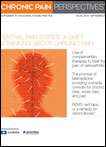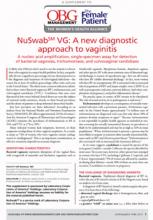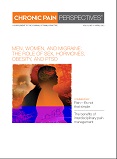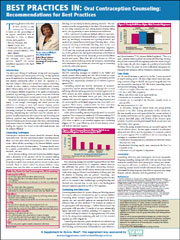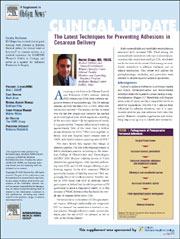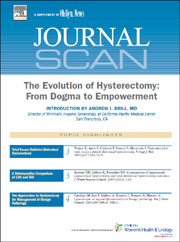User login
Chronic Pain Perspectives - September 2011
- Central pain states: a shift in thinking about chronic pain
- Use of complementary therapies to treat the pain of osteoarthritis
- The promise of telemedicine: providing curbside consults for chronic care, acute care, and pain
- REMS: red tape, or a remedy for opioid abuse?
- Central pain states: a shift in thinking about chronic pain
- Use of complementary therapies to treat the pain of osteoarthritis
- The promise of telemedicine: providing curbside consults for chronic care, acute care, and pain
- REMS: red tape, or a remedy for opioid abuse?
- Central pain states: a shift in thinking about chronic pain
- Use of complementary therapies to treat the pain of osteoarthritis
- The promise of telemedicine: providing curbside consults for chronic care, acute care, and pain
- REMS: red tape, or a remedy for opioid abuse?
Pain - It's not that simple
H. L. Mencken was a 20th century journalist and critic who provided us with a number of great quotes. One of my favorites is:
“There is always an easy solution to every human problem—neat, plausible, and wrong."1
I like this quote because it applies to many aspects of pain. In this and upcoming issues of Chronic Pain Perspectives, we examine why chronic pain needs to be viewed as a complex situation that affects the mind, body, and soul of our patients, one in which the simple, neat solution is often not enough. Although we may wish to “tackle” pain as we would an objective value and reduce it with a unimodal approach, experience and several lines of research demonstrate that we are positioning ourselves, and our patients, for disappointment. The problem here is not in our patients, but in the fact that their pain is not a discrete entity. Pain is a doorway into a sequela of suffering that needs to be appreciated and addressed if we have any hope of helping our patients return to functionality.
Pain does not travel alone
The research guides us to understand that when there is pain, there are current or emerging issues with mood, energy, cognition, and function. Although depression is found in approximately 10% to 15% of all patients seen in primary care, those who have chronic pain have been found to present with depression as much as 58% of the time,2 making it the most common psychiatric comorbidity. Conversely, in a large study of primary care patients with major depressive disorder, chronic pain was present nearly 66% of the time.3
Beyond depression, the patient with chronic pain is more likely to have coexisting anxiety,3 panic,3 sleep dysfunction characterized by sleep maintenance insomnia and fatigue,4 restless leg syndrome,4 and loss of gray matter density that may be reversible.5,6 This brings up the age-old intellectual question, “Which came first?” What we appreciate more and more—through understanding the common pathophysiological mechanisms seen in conditions such as migraine, depression, and cardiovascular disease,7—is that these disorders are co-developing and making their way into the chief complaint in various layers and word choices.
Pain does not stay in the same silo
As we focus more closely on pain as a foe that we can subdue, we find that it exerts an influence on many “friends,” and that pain and its elusive friends have the ability to jump from one arena into another, sometimes making the battle feel insurmountable. Recent research points this out; in a 30-year study of headache, over the course of their illness patients were found to switch from their initial diagnosis of headache type to other headache diagnoses more than 80% of the time.8[Figure]
FIGURE: Combinations of headache subtypes across 30 years among participants
who met criteria for migraine or tension-type headache (n=346)
Source: Adapted from Merikangas KR, et al. Magnitude, impact, and stability of
primary headache subtypes: 30 year prospective Swiss cohort study. BMJ. 2011;343:d5706
What this creates is the awareness that we are not really fighting a single condition, but a complex picture of suffering, and that we must take into account many layers of the patient who presents to us. In this way we can push past the simple but disappointing solution to a more integrative, individualized, complex one that holds the potential for relief on multiple levels.
I’ll leave you with another Mencken quote that offers sage advice in this regard:
“The essence of science is that it is always willing to abandon a given idea, however fundamental it may seem to be, for a better one.“9
1. Mencken HL. “The Divine Afflatus,” A Mencken Chrestomathy. Chapter 25, p. 443. 1949.
2. Castro M, Kraychete D, Daltro C, et al. Comorbid anxiety and depression disorders in patients with chronic pain. Arq Neuropsiquiatr. 2009;67(4):982-985.
3. Arnow BA, Hunkeler EN, Blasey CM, et al. Comorbid depression, chronic pain, and disability in primary care. Psychosom Med. 2006;68:262-268.
4. Alattar M, Harrington JJ, Mitchell CM, et al. Sleep problems in primary care: A North Carolina Family Practice Research Network (NC_FP_RN) study. J Am Bd Fam Med. 2007;20(4)365-374.
5. Apkarian AV, Sosa Y, Sonty S, et al. Chronic back pain is associated with decreased prefrontal and thalamic gray matter density. J Neurosci. 2004;24(46):10410-10415.
6. Seminowicz DA, Wideman TH, Naso L, et al. Effective treatment of chronic low back pain in humans reverses abnormal brain anatomy and function. J Neurosci. 2011;31(20)7540-7550.
7. Park KIE, Pepine CJ. Pathophysiologic mechanisms linking impaired cardiovascular health and neurologic function: the year in review. Clev Clin J Med. 2010;77(suppl 3):S40-S45.
8. Merikangas KR, Cui L, Kalydjian, et al. Magnitude, impact, and stability of primary headache subtypes: 30 year prospective Swiss cohort study. BMJ. 2011;343:d5706.
9. Mencken HL. Minority Report, no 232. 1956.
H. L. Mencken was a 20th century journalist and critic who provided us with a number of great quotes. One of my favorites is:
“There is always an easy solution to every human problem—neat, plausible, and wrong."1
I like this quote because it applies to many aspects of pain. In this and upcoming issues of Chronic Pain Perspectives, we examine why chronic pain needs to be viewed as a complex situation that affects the mind, body, and soul of our patients, one in which the simple, neat solution is often not enough. Although we may wish to “tackle” pain as we would an objective value and reduce it with a unimodal approach, experience and several lines of research demonstrate that we are positioning ourselves, and our patients, for disappointment. The problem here is not in our patients, but in the fact that their pain is not a discrete entity. Pain is a doorway into a sequela of suffering that needs to be appreciated and addressed if we have any hope of helping our patients return to functionality.
Pain does not travel alone
The research guides us to understand that when there is pain, there are current or emerging issues with mood, energy, cognition, and function. Although depression is found in approximately 10% to 15% of all patients seen in primary care, those who have chronic pain have been found to present with depression as much as 58% of the time,2 making it the most common psychiatric comorbidity. Conversely, in a large study of primary care patients with major depressive disorder, chronic pain was present nearly 66% of the time.3
Beyond depression, the patient with chronic pain is more likely to have coexisting anxiety,3 panic,3 sleep dysfunction characterized by sleep maintenance insomnia and fatigue,4 restless leg syndrome,4 and loss of gray matter density that may be reversible.5,6 This brings up the age-old intellectual question, “Which came first?” What we appreciate more and more—through understanding the common pathophysiological mechanisms seen in conditions such as migraine, depression, and cardiovascular disease,7—is that these disorders are co-developing and making their way into the chief complaint in various layers and word choices.
Pain does not stay in the same silo
As we focus more closely on pain as a foe that we can subdue, we find that it exerts an influence on many “friends,” and that pain and its elusive friends have the ability to jump from one arena into another, sometimes making the battle feel insurmountable. Recent research points this out; in a 30-year study of headache, over the course of their illness patients were found to switch from their initial diagnosis of headache type to other headache diagnoses more than 80% of the time.8[Figure]
FIGURE: Combinations of headache subtypes across 30 years among participants
who met criteria for migraine or tension-type headache (n=346)
Source: Adapted from Merikangas KR, et al. Magnitude, impact, and stability of
primary headache subtypes: 30 year prospective Swiss cohort study. BMJ. 2011;343:d5706
What this creates is the awareness that we are not really fighting a single condition, but a complex picture of suffering, and that we must take into account many layers of the patient who presents to us. In this way we can push past the simple but disappointing solution to a more integrative, individualized, complex one that holds the potential for relief on multiple levels.
I’ll leave you with another Mencken quote that offers sage advice in this regard:
“The essence of science is that it is always willing to abandon a given idea, however fundamental it may seem to be, for a better one.“9
H. L. Mencken was a 20th century journalist and critic who provided us with a number of great quotes. One of my favorites is:
“There is always an easy solution to every human problem—neat, plausible, and wrong."1
I like this quote because it applies to many aspects of pain. In this and upcoming issues of Chronic Pain Perspectives, we examine why chronic pain needs to be viewed as a complex situation that affects the mind, body, and soul of our patients, one in which the simple, neat solution is often not enough. Although we may wish to “tackle” pain as we would an objective value and reduce it with a unimodal approach, experience and several lines of research demonstrate that we are positioning ourselves, and our patients, for disappointment. The problem here is not in our patients, but in the fact that their pain is not a discrete entity. Pain is a doorway into a sequela of suffering that needs to be appreciated and addressed if we have any hope of helping our patients return to functionality.
Pain does not travel alone
The research guides us to understand that when there is pain, there are current or emerging issues with mood, energy, cognition, and function. Although depression is found in approximately 10% to 15% of all patients seen in primary care, those who have chronic pain have been found to present with depression as much as 58% of the time,2 making it the most common psychiatric comorbidity. Conversely, in a large study of primary care patients with major depressive disorder, chronic pain was present nearly 66% of the time.3
Beyond depression, the patient with chronic pain is more likely to have coexisting anxiety,3 panic,3 sleep dysfunction characterized by sleep maintenance insomnia and fatigue,4 restless leg syndrome,4 and loss of gray matter density that may be reversible.5,6 This brings up the age-old intellectual question, “Which came first?” What we appreciate more and more—through understanding the common pathophysiological mechanisms seen in conditions such as migraine, depression, and cardiovascular disease,7—is that these disorders are co-developing and making their way into the chief complaint in various layers and word choices.
Pain does not stay in the same silo
As we focus more closely on pain as a foe that we can subdue, we find that it exerts an influence on many “friends,” and that pain and its elusive friends have the ability to jump from one arena into another, sometimes making the battle feel insurmountable. Recent research points this out; in a 30-year study of headache, over the course of their illness patients were found to switch from their initial diagnosis of headache type to other headache diagnoses more than 80% of the time.8[Figure]
FIGURE: Combinations of headache subtypes across 30 years among participants
who met criteria for migraine or tension-type headache (n=346)
Source: Adapted from Merikangas KR, et al. Magnitude, impact, and stability of
primary headache subtypes: 30 year prospective Swiss cohort study. BMJ. 2011;343:d5706
What this creates is the awareness that we are not really fighting a single condition, but a complex picture of suffering, and that we must take into account many layers of the patient who presents to us. In this way we can push past the simple but disappointing solution to a more integrative, individualized, complex one that holds the potential for relief on multiple levels.
I’ll leave you with another Mencken quote that offers sage advice in this regard:
“The essence of science is that it is always willing to abandon a given idea, however fundamental it may seem to be, for a better one.“9
1. Mencken HL. “The Divine Afflatus,” A Mencken Chrestomathy. Chapter 25, p. 443. 1949.
2. Castro M, Kraychete D, Daltro C, et al. Comorbid anxiety and depression disorders in patients with chronic pain. Arq Neuropsiquiatr. 2009;67(4):982-985.
3. Arnow BA, Hunkeler EN, Blasey CM, et al. Comorbid depression, chronic pain, and disability in primary care. Psychosom Med. 2006;68:262-268.
4. Alattar M, Harrington JJ, Mitchell CM, et al. Sleep problems in primary care: A North Carolina Family Practice Research Network (NC_FP_RN) study. J Am Bd Fam Med. 2007;20(4)365-374.
5. Apkarian AV, Sosa Y, Sonty S, et al. Chronic back pain is associated with decreased prefrontal and thalamic gray matter density. J Neurosci. 2004;24(46):10410-10415.
6. Seminowicz DA, Wideman TH, Naso L, et al. Effective treatment of chronic low back pain in humans reverses abnormal brain anatomy and function. J Neurosci. 2011;31(20)7540-7550.
7. Park KIE, Pepine CJ. Pathophysiologic mechanisms linking impaired cardiovascular health and neurologic function: the year in review. Clev Clin J Med. 2010;77(suppl 3):S40-S45.
8. Merikangas KR, Cui L, Kalydjian, et al. Magnitude, impact, and stability of primary headache subtypes: 30 year prospective Swiss cohort study. BMJ. 2011;343:d5706.
9. Mencken HL. Minority Report, no 232. 1956.
1. Mencken HL. “The Divine Afflatus,” A Mencken Chrestomathy. Chapter 25, p. 443. 1949.
2. Castro M, Kraychete D, Daltro C, et al. Comorbid anxiety and depression disorders in patients with chronic pain. Arq Neuropsiquiatr. 2009;67(4):982-985.
3. Arnow BA, Hunkeler EN, Blasey CM, et al. Comorbid depression, chronic pain, and disability in primary care. Psychosom Med. 2006;68:262-268.
4. Alattar M, Harrington JJ, Mitchell CM, et al. Sleep problems in primary care: A North Carolina Family Practice Research Network (NC_FP_RN) study. J Am Bd Fam Med. 2007;20(4)365-374.
5. Apkarian AV, Sosa Y, Sonty S, et al. Chronic back pain is associated with decreased prefrontal and thalamic gray matter density. J Neurosci. 2004;24(46):10410-10415.
6. Seminowicz DA, Wideman TH, Naso L, et al. Effective treatment of chronic low back pain in humans reverses abnormal brain anatomy and function. J Neurosci. 2011;31(20)7540-7550.
7. Park KIE, Pepine CJ. Pathophysiologic mechanisms linking impaired cardiovascular health and neurologic function: the year in review. Clev Clin J Med. 2010;77(suppl 3):S40-S45.
8. Merikangas KR, Cui L, Kalydjian, et al. Magnitude, impact, and stability of primary headache subtypes: 30 year prospective Swiss cohort study. BMJ. 2011;343:d5706.
9. Mencken HL. Minority Report, no 232. 1956.
NuSwabSM: A new diagnostic approach to vaginitis
Chronic Pain Perspectives - April 2012
• Pain—it’s not that simple
• Men, women, and migraine: The role of sex, hormones, obesity, and PTSD
• The benefits of interdisciplinary pain management
• Pain—it’s not that simple
• Men, women, and migraine: The role of sex, hormones, obesity, and PTSD
• The benefits of interdisciplinary pain management
• Pain—it’s not that simple
• Men, women, and migraine: The role of sex, hormones, obesity, and PTSD
• The benefits of interdisciplinary pain management
BEST PRACTICES IN: The Treatment of Heavy Menstrual Bleeding
A supplement to Ob.Gyn. News. This supplement was sponsored by Ferring Pharmaceuticals.
•Topics
•Faculty/Faculty Disclosure
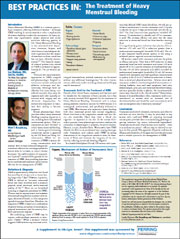
To view the supplement, click the image above.
Topics
• Introduction
• Definition & Diagnosis
• Tranexamic Acid for the Treatment of HMB
• Conclusion
Faculty/Faculty Disclosure
Lee Shulman, MD, FACOG, FACMG
The Anna Ross Lapham Professor in Obstetrics and Gynecology
Feinberg School of Medicine of Northwestern University
Chicago, Illinois
Dr Shulman is a consultant to Ferring Pharmaceuticals, Inc.
Matt T. Rosenberg, MD
Family Physician
Mid-Michigan Health Centers
Jackson, Michigan
Dr Rosenberg is a consultant to Ferring Pharmaceuticals, Inc.
Copyright © 2011 by Elsevier Inc.
A supplement to Ob.Gyn. News. This supplement was sponsored by Ferring Pharmaceuticals.
•Topics
•Faculty/Faculty Disclosure

To view the supplement, click the image above.
Topics
• Introduction
• Definition & Diagnosis
• Tranexamic Acid for the Treatment of HMB
• Conclusion
Faculty/Faculty Disclosure
Lee Shulman, MD, FACOG, FACMG
The Anna Ross Lapham Professor in Obstetrics and Gynecology
Feinberg School of Medicine of Northwestern University
Chicago, Illinois
Dr Shulman is a consultant to Ferring Pharmaceuticals, Inc.
Matt T. Rosenberg, MD
Family Physician
Mid-Michigan Health Centers
Jackson, Michigan
Dr Rosenberg is a consultant to Ferring Pharmaceuticals, Inc.
Copyright © 2011 by Elsevier Inc.
A supplement to Ob.Gyn. News. This supplement was sponsored by Ferring Pharmaceuticals.
•Topics
•Faculty/Faculty Disclosure

To view the supplement, click the image above.
Topics
• Introduction
• Definition & Diagnosis
• Tranexamic Acid for the Treatment of HMB
• Conclusion
Faculty/Faculty Disclosure
Lee Shulman, MD, FACOG, FACMG
The Anna Ross Lapham Professor in Obstetrics and Gynecology
Feinberg School of Medicine of Northwestern University
Chicago, Illinois
Dr Shulman is a consultant to Ferring Pharmaceuticals, Inc.
Matt T. Rosenberg, MD
Family Physician
Mid-Michigan Health Centers
Jackson, Michigan
Dr Rosenberg is a consultant to Ferring Pharmaceuticals, Inc.
Copyright © 2011 by Elsevier Inc.
CLINICAL UPDATE:Evaluating Endometrial Ablation Options: A Guide for Evidence-Based Decision Making
Evaluating Endometrial Ablation Options: A Guide for Evidence-Based Decision Making
A supplement to Ob.Gyn. News.
This supplement was sponsored by ETHICON Women's Health & Urology.

To view the supplement, click the image above.
Topic Highlights
• The Evolution of Thermal Balloon Therapy
• Understanding the Mechanism of Action for Thermal Balloon Therapy
• Menorrhagia-Associated Dysmenorrhea
• Importance of endometrial Cavitary Coverage
• A Review of Research on Clinical Efficacy
• Thermal Balloon Ablation After Cesarean Section
• Should Thermal Balloon Therapy Be Performed in the Office?
Faculty/Faculty Disclosures
Hector O. Chapa, MD
Medical Director and Outreach Coordinator
Women's Specialty Center
Clinical Faculty
Methodist Medical Center
Department of Obstetrics and Gynecology Residency ProgramDallas, TX
Dr. Chapa is a medical consultant for ETHICON Women's Health & Urology and has coauthored its Professional Education Content for ThermaChoice Balloon Ablation.
Lowell L. McCauley, MD, PC
Obstetrician/Gynecologist
Knoxville, TN
Dr. McCauley is a medical consultant for ETHICON Women's Health & Urology. To date, he has successfully completed more than 400 Thermachoice III endometrial ablations and serves as a physician educator and trainer for the procedure.
A supplement to Ob.Gyn. News.
This supplement was sponsored by ETHICON Women's Health & Urology.

To view the supplement, click the image above.
Topic Highlights
• The Evolution of Thermal Balloon Therapy
• Understanding the Mechanism of Action for Thermal Balloon Therapy
• Menorrhagia-Associated Dysmenorrhea
• Importance of endometrial Cavitary Coverage
• A Review of Research on Clinical Efficacy
• Thermal Balloon Ablation After Cesarean Section
• Should Thermal Balloon Therapy Be Performed in the Office?
Faculty/Faculty Disclosures
Hector O. Chapa, MD
Medical Director and Outreach Coordinator
Women's Specialty Center
Clinical Faculty
Methodist Medical Center
Department of Obstetrics and Gynecology Residency ProgramDallas, TX
Dr. Chapa is a medical consultant for ETHICON Women's Health & Urology and has coauthored its Professional Education Content for ThermaChoice Balloon Ablation.
Lowell L. McCauley, MD, PC
Obstetrician/Gynecologist
Knoxville, TN
Dr. McCauley is a medical consultant for ETHICON Women's Health & Urology. To date, he has successfully completed more than 400 Thermachoice III endometrial ablations and serves as a physician educator and trainer for the procedure.
A supplement to Ob.Gyn. News.
This supplement was sponsored by ETHICON Women's Health & Urology.

To view the supplement, click the image above.
Topic Highlights
• The Evolution of Thermal Balloon Therapy
• Understanding the Mechanism of Action for Thermal Balloon Therapy
• Menorrhagia-Associated Dysmenorrhea
• Importance of endometrial Cavitary Coverage
• A Review of Research on Clinical Efficacy
• Thermal Balloon Ablation After Cesarean Section
• Should Thermal Balloon Therapy Be Performed in the Office?
Faculty/Faculty Disclosures
Hector O. Chapa, MD
Medical Director and Outreach Coordinator
Women's Specialty Center
Clinical Faculty
Methodist Medical Center
Department of Obstetrics and Gynecology Residency ProgramDallas, TX
Dr. Chapa is a medical consultant for ETHICON Women's Health & Urology and has coauthored its Professional Education Content for ThermaChoice Balloon Ablation.
Lowell L. McCauley, MD, PC
Obstetrician/Gynecologist
Knoxville, TN
Dr. McCauley is a medical consultant for ETHICON Women's Health & Urology. To date, he has successfully completed more than 400 Thermachoice III endometrial ablations and serves as a physician educator and trainer for the procedure.
Evaluating Endometrial Ablation Options: A Guide for Evidence-Based Decision Making
Evaluating Endometrial Ablation Options: A Guide for Evidence-Based Decision Making
BEST PRACTICES IN: Oral Contraception Counseling: Recommendations for Best Practices
A supplement to Ob.Gyn. News. This supplement was sponsored by TEVA Women's Health.
•Topics
•Faculty/Faculty Disclosure
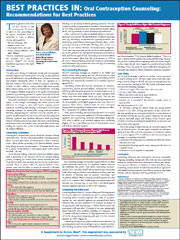
To view the supplement, click the image above.
Topics
• Counseling Techniques
• Key Counseling Messages
• Counseling and Adherence
• Case Study
Faculty/Faculty Disclosure
Versie Johnson-Mallard, PhD, MSN, MSMS
Nurse Faculty Scholar
Robert Wood Johnson
University of South Florida
Tampa, FL
Dr Johnson-Mallard has nothing to disclose.
Copyright © 2011 by Elsevier Inc.
A supplement to Ob.Gyn. News. This supplement was sponsored by TEVA Women's Health.
•Topics
•Faculty/Faculty Disclosure

To view the supplement, click the image above.
Topics
• Counseling Techniques
• Key Counseling Messages
• Counseling and Adherence
• Case Study
Faculty/Faculty Disclosure
Versie Johnson-Mallard, PhD, MSN, MSMS
Nurse Faculty Scholar
Robert Wood Johnson
University of South Florida
Tampa, FL
Dr Johnson-Mallard has nothing to disclose.
Copyright © 2011 by Elsevier Inc.
A supplement to Ob.Gyn. News. This supplement was sponsored by TEVA Women's Health.
•Topics
•Faculty/Faculty Disclosure

To view the supplement, click the image above.
Topics
• Counseling Techniques
• Key Counseling Messages
• Counseling and Adherence
• Case Study
Faculty/Faculty Disclosure
Versie Johnson-Mallard, PhD, MSN, MSMS
Nurse Faculty Scholar
Robert Wood Johnson
University of South Florida
Tampa, FL
Dr Johnson-Mallard has nothing to disclose.
Copyright © 2011 by Elsevier Inc.
Clinical UpdateThe Latest Techniques for Preventing Adhesions in Cesarean Delivery
The Latest Techniques for Preventing Adhesions in Cesarean Delivery
A supplement to Ob.Gyn. News. This supplement was sponsored by Ethicon Women's Health & Urology.
•Topics
•Faculty/Faculty Disclosure

To view the supplement, click the image above.
Topics
• Introduction
• Adhesiogenesis
• Adhesion Frequency in Cesarean Deliveries
• General and Obstetric Sequelae of Adhesions
• Where Are Adhesions Most Likely to Develop?
• Should We Do Peritoneal Closure?
• Adhesion Prevention
• Data on Clinical Effectiveness
• Using ORC at Cesarean Delivery
Faculty/Faculty Disclosure
Hector Chapa, MD, FACOG
Medical Director and Outreach Coordinator
Women's Specialty Center
Clinical Faculty
Obstetrics and Gynecology
Residency Program
Methodist Medical Center
Dallas, Texas
Dr Chapa has received clinical grant funding from Johnson & Johnson Medical Affairs for clinical trials of Interceed
A supplement to Ob.Gyn. News. This supplement was sponsored by Ethicon Women's Health & Urology.
•Topics
•Faculty/Faculty Disclosure

To view the supplement, click the image above.
Topics
• Introduction
• Adhesiogenesis
• Adhesion Frequency in Cesarean Deliveries
• General and Obstetric Sequelae of Adhesions
• Where Are Adhesions Most Likely to Develop?
• Should We Do Peritoneal Closure?
• Adhesion Prevention
• Data on Clinical Effectiveness
• Using ORC at Cesarean Delivery
Faculty/Faculty Disclosure
Hector Chapa, MD, FACOG
Medical Director and Outreach Coordinator
Women's Specialty Center
Clinical Faculty
Obstetrics and Gynecology
Residency Program
Methodist Medical Center
Dallas, Texas
Dr Chapa has received clinical grant funding from Johnson & Johnson Medical Affairs for clinical trials of Interceed
A supplement to Ob.Gyn. News. This supplement was sponsored by Ethicon Women's Health & Urology.
•Topics
•Faculty/Faculty Disclosure

To view the supplement, click the image above.
Topics
• Introduction
• Adhesiogenesis
• Adhesion Frequency in Cesarean Deliveries
• General and Obstetric Sequelae of Adhesions
• Where Are Adhesions Most Likely to Develop?
• Should We Do Peritoneal Closure?
• Adhesion Prevention
• Data on Clinical Effectiveness
• Using ORC at Cesarean Delivery
Faculty/Faculty Disclosure
Hector Chapa, MD, FACOG
Medical Director and Outreach Coordinator
Women's Specialty Center
Clinical Faculty
Obstetrics and Gynecology
Residency Program
Methodist Medical Center
Dallas, Texas
Dr Chapa has received clinical grant funding from Johnson & Johnson Medical Affairs for clinical trials of Interceed
The Latest Techniques for Preventing Adhesions in Cesarean Delivery
The Latest Techniques for Preventing Adhesions in Cesarean Delivery
BEST PRACTICES IN: Addressing Misperceptions Related to Unscheduled Bleeding in Women Taking Combined Oral Contraceptives: Counseling Is the Key
A supplement to Ob.Gyn. News. This supplement was sponsored by TEVA Women's Health.
•Topics
•Faculty/Faculty Disclosure

To view the supplement, click the image above.
Topics
• Defining OC-Related Bleeding
• Differences Among OC Regimens
• Management of OC-Related Bleeding
Faculty/Faculty Disclosure
Christopher M. Estes, MD, MPH
Assistant Professor
Director, Clerkship in Obstetrics and Gynecology
Medical Director
Reproductive Health Services
University of Miami Miller, School of Medicine
Department of Obstetrics and Gynecology
Miami, FL
Mandy Gittler, MD
Medical Director
All Women's Health
Chicago, IL and Tacoma, WA
Dr Estes has nothing to disclose. Dr Gittler is a consultant to, and has received funding for clinical grants from TEVA Women's Health.
Copyright © 2011 by Elsevier Inc.
A supplement to Ob.Gyn. News. This supplement was sponsored by TEVA Women's Health.
•Topics
•Faculty/Faculty Disclosure

To view the supplement, click the image above.
Topics
• Defining OC-Related Bleeding
• Differences Among OC Regimens
• Management of OC-Related Bleeding
Faculty/Faculty Disclosure
Christopher M. Estes, MD, MPH
Assistant Professor
Director, Clerkship in Obstetrics and Gynecology
Medical Director
Reproductive Health Services
University of Miami Miller, School of Medicine
Department of Obstetrics and Gynecology
Miami, FL
Mandy Gittler, MD
Medical Director
All Women's Health
Chicago, IL and Tacoma, WA
Dr Estes has nothing to disclose. Dr Gittler is a consultant to, and has received funding for clinical grants from TEVA Women's Health.
Copyright © 2011 by Elsevier Inc.
A supplement to Ob.Gyn. News. This supplement was sponsored by TEVA Women's Health.
•Topics
•Faculty/Faculty Disclosure

To view the supplement, click the image above.
Topics
• Defining OC-Related Bleeding
• Differences Among OC Regimens
• Management of OC-Related Bleeding
Faculty/Faculty Disclosure
Christopher M. Estes, MD, MPH
Assistant Professor
Director, Clerkship in Obstetrics and Gynecology
Medical Director
Reproductive Health Services
University of Miami Miller, School of Medicine
Department of Obstetrics and Gynecology
Miami, FL
Mandy Gittler, MD
Medical Director
All Women's Health
Chicago, IL and Tacoma, WA
Dr Estes has nothing to disclose. Dr Gittler is a consultant to, and has received funding for clinical grants from TEVA Women's Health.
Copyright © 2011 by Elsevier Inc.
JOURNAL SCANThe Evolution of Hysterectomy: From Dogma to Empowerment
The Evolution of Hysterectomy: From Dogma to Empowerment
A supplement to Ob.Gyn. News. This supplement was sponsored by Ethicon Women's Health & Urology.
•Topics
•Faculty/Faculty Disclosure
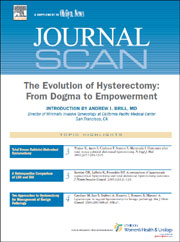
To view the supplement, click the image above.
Topics
• Introduction
• Total Versus Subtotal Abdominal Hysterectomy
• A Retrospective Comparison of LSH and TAH
• Two Approaches to Hysterectomy for Management of Benign Pathology
Faculty/Faculty Disclosure
Andrew I. Brill, MD
Director of Minimally Invasive Gynecology at California Pacific Medical Center
San Francisco, CA
Dr. Brill has a consulting agreement with Cephalon, Inc., Ethicon, Inc., and Karl Storz GmbH & Co. KG.
Copyright © 2010 by Elsevier Inc.
A supplement to Ob.Gyn. News. This supplement was sponsored by Ethicon Women's Health & Urology.
•Topics
•Faculty/Faculty Disclosure

To view the supplement, click the image above.
Topics
• Introduction
• Total Versus Subtotal Abdominal Hysterectomy
• A Retrospective Comparison of LSH and TAH
• Two Approaches to Hysterectomy for Management of Benign Pathology
Faculty/Faculty Disclosure
Andrew I. Brill, MD
Director of Minimally Invasive Gynecology at California Pacific Medical Center
San Francisco, CA
Dr. Brill has a consulting agreement with Cephalon, Inc., Ethicon, Inc., and Karl Storz GmbH & Co. KG.
Copyright © 2010 by Elsevier Inc.
A supplement to Ob.Gyn. News. This supplement was sponsored by Ethicon Women's Health & Urology.
•Topics
•Faculty/Faculty Disclosure

To view the supplement, click the image above.
Topics
• Introduction
• Total Versus Subtotal Abdominal Hysterectomy
• A Retrospective Comparison of LSH and TAH
• Two Approaches to Hysterectomy for Management of Benign Pathology
Faculty/Faculty Disclosure
Andrew I. Brill, MD
Director of Minimally Invasive Gynecology at California Pacific Medical Center
San Francisco, CA
Dr. Brill has a consulting agreement with Cephalon, Inc., Ethicon, Inc., and Karl Storz GmbH & Co. KG.
Copyright © 2010 by Elsevier Inc.
The Evolution of Hysterectomy: From Dogma to Empowerment
The Evolution of Hysterectomy: From Dogma to Empowerment
